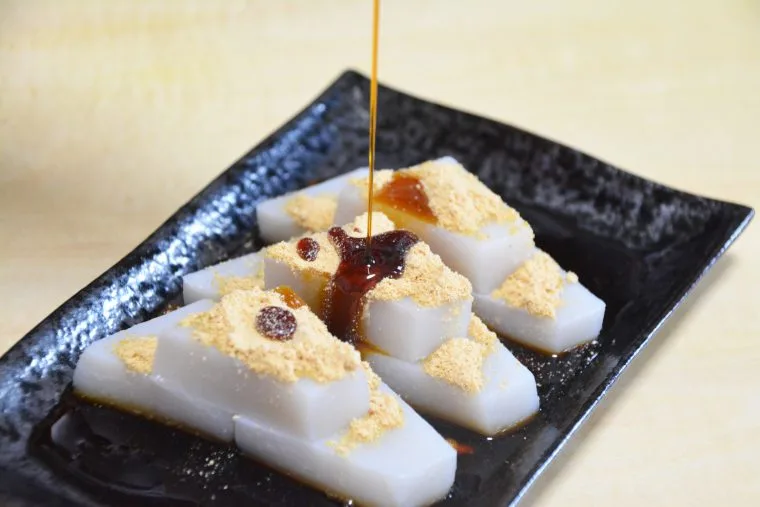Kuzu mochi and Kuzu mochi: Two Traditional Japanese Sweets with the Same Name but Different Origins
Exemplifying the richness of Japanese confectionery culture, there exist two entirely different sweets that share the same pronunciation: “kuzu mochi.” One is the “kuzu mochi” (葛餅) from the Kansai region, and the other is the “kuzu mochi” (くず餅) from the Kanto region. While they may seem to refer to the same thing at first glance, these two sweets differ significantly in their ingredients, preparation methods, and flavors. Let’s delve into the charm of these two “kuzu mochi.”
Kansai’s Kuzu mochi: The Elegant Flavor of Kuzu Powder
Kansai (southern-central region)’s kuzu mochi is made primarily from kuzu powder, as its name suggests. Kuzu is a leguminous vine plant, and the starch extracted from its roots is used as kuzu powder. Kuzu powder has long been valued for its nutritional benefits and was also used as medicine.
The preparation of kuzu mochi is relatively simple. Kuzu powder is mixed with sugar and water, kneaded, and then steamed until firm. The resulting kuzu mochi has a beautiful translucent white appearance, with a smooth texture and refined sweetness. One of its charms is the unique mouthfeel, almost as if it’s melting in your mouth.
Kansai’s kuzu mochi is also known as a wagashi that represents the summer season. Its cool appearance and refreshing taste have made it a popular sweet to enjoy during the hot summer months.

Kanto’s Kuzu mochi: A Simple Flavor Born from Wheat Flour
On the other hand, Kanto’s kuzu mochi is primarily made from wheat flour. Despite having “kuzu” in its name, it contains little to no kuzu powder.
The preparation method for Kanto’s kuzumochi involves kneading wheat flour with water, letting the dough ferment for a long time, then boiling and solidifying it. The finished kuzumochi has a slightly grayish color and a chewy texture.
Kanto’s kuzu mochi is typically eaten with kinako (roasted soybean flour) and kuromitsu (black sugar syrup). The combination of the simple flavor of the kuzu mochi with the aromatic kinako and sweet kuromitsu creates a unique and delicious taste.

The History of Kuzu mochi: Origins and Development
The history of Kansai’s kuzu mochi dates back to the Nara period (710-794). It is said to have originated as a way to make kuzu powder, which was valued as medicine, easier to consume. The Yoshino region in Nara Prefecture is known for producing high-quality kuzu, and “Yoshino kuzu” has become synonymous with premium kuzu powder.
The origin of Kanto’s kuzu mochi, on the other hand, is traced back to the Edo period (1603-1867). At that time, wheat was widely used as a rice substitute, and kuzu mochi emerged as a common sweet enjoyed by ordinary people. The Mukojima area in Taito Ward, Tokyo, is particularly known as a famous production area for kuzu mochi.
Both sweets have evolved into their current forms over many years, reflecting the food culture and history of their respective regions.
Enjoying Kuzu mochi: Seasons and Ways to Eat
Kansai’s kuzu mochi is primarily eaten in summer. Its cool appearance and refreshing taste make it a perfect wagashi for the hot season. Kuzu mochi is usually eaten with sweet red bean paste, but recently, new ways of enjoying it, such as serving it with seasonal fruits, have become popular.
In contrast, Kanto’s kuzu mochi is enjoyed throughout the year. The traditional way of eating it with kinako and kuromitsu can be enjoyed in any season. It’s especially refreshing when chilled in summer, and some people even enjoy warm kuzu mochi in winter.
Both are typically enjoyed with tea. It’s recommended to pair Kansai’s kuzu mochi with cold green tea and Kanto’s kuzu mochi with hot hojicha (roasted green tea).
Anecdotes about Kuzu mochi: Deep Connections with Culture
Kuzu mochi and kuzu mochi hold cultural significance beyond being mere sweets. For instance, Kansai’s kuzu mochi, due to its medicinal aspects, was often consumed for fatigue recovery and nutritional benefits.
Kanto’s kuzu mochi is a traditional sweet that has been enjoyed since the Edo period and has been loved by many people. The “Ganso Kuzu mochi” from Funabashiya is known as a long-established shop that preserves the taste from the Edo period. It’s also famous for being a favorite of the literary giant Ryunosuke Akutagawa.
In this way, kuzu mochi and kuzu mochi are deeply connected with the food culture, history, and literature of their respective regions, and have been carefully passed down to this day as wagashi with meanings beyond mere sweets.
Despite sharing the same name “kuzu mochi,” these two sweets are entirely different. Kansai’s kuzu mochi and Kanto’s kuzu mochi symbolize the depth of Japanese wagashi culture, reflecting the food culture and history of their respective regions. If you have the opportunity, try comparing both. As you enjoy their unique flavors and textures, you’ll be able to appreciate the diversity of Japanese food culture.
